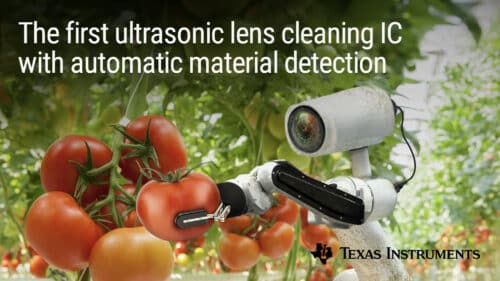The technology enables camera systems to self-clean using ultrasonic vibrations, improving accuracy and reducing maintenance by removing dirt, ice, and water.

Texas Instruments (TI) has introduced semiconductors with ultrasonic lens cleaning (ULC) technology. This technology lets camera systems detect and remove dirt, ice, and water using vibrations.
Removing contaminants from camera lenses traditionally required manual cleaning or mechanical parts that could fail. TI’s ULC chipset, including the ULC1001 digital signal processor (DSP) and the DRV2901 piezo transducer driver, uses technology that enables cameras to self-clean by using controlled vibrations to eliminate debris. This improves system accuracy and reduces maintenance needs. The chipset offers a solution for integrating ULC technology into various applications and camera sizes.
The controller includes automatic sensing, cleaning, temperature and fault detection algorithms without image processing, making ULC technology adaptable to camera lens designs. The chipset’s small form factor improves machine vision and sensing in various applications where cameras or sensors could get dirty.
The ULC chipset eliminates the need for complex mechanical parts and human intervention in lens cleaning systems. The ultrasonic cleaning DSP integrates a pulse-width modulator, current- and voltage-sense amplifiers, and an analog-to-digital converter. Used with the DRV2901 piezo transducer driver, The chipset enables ULC in a compact footprint, with a printed circuit board size less than 25 mm by 15 mm, reducing the bill of materials and providing more functionality than a discrete implementation.
“ULC can make widespread use of self-cleaning cameras and sensors a reality. Existing cleaning approaches are expensive and impractical, requiring complicated mechanics, costly electronics and significant processing to detect contaminants and execute cleaning,” said Avi Yashar, product marketing engineer at TI. “With the recent proliferation of cameras in various applications, from automotive and traffic cameras to smart cities and manufacturing, there’s a strong need for a simple, cost-effective way to enable self-cleaning cameras.”
For more information, click here.













